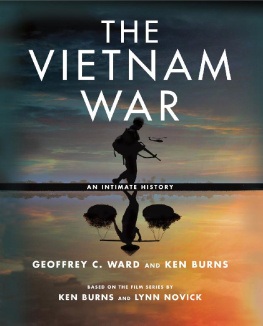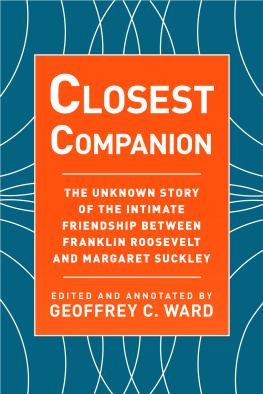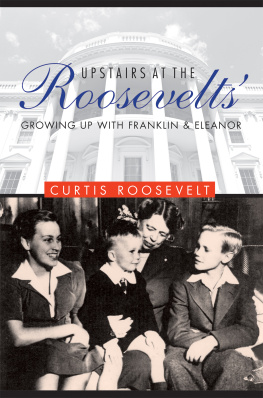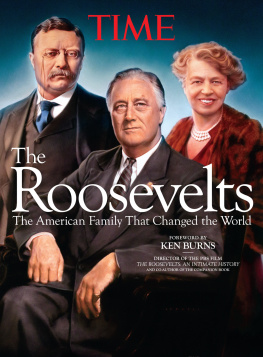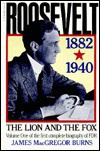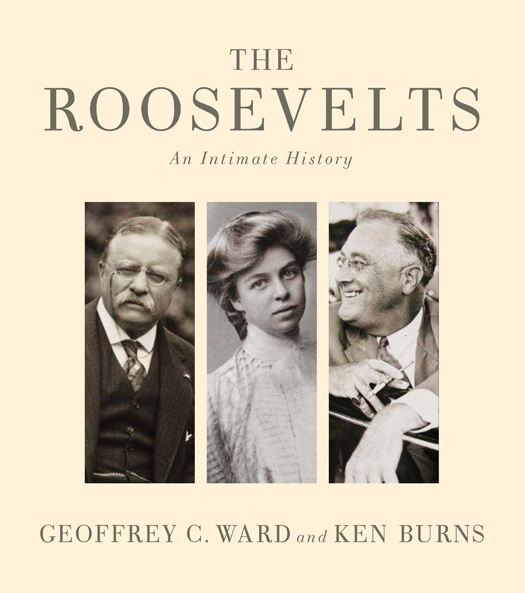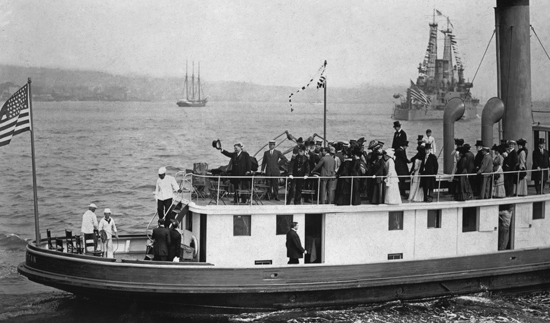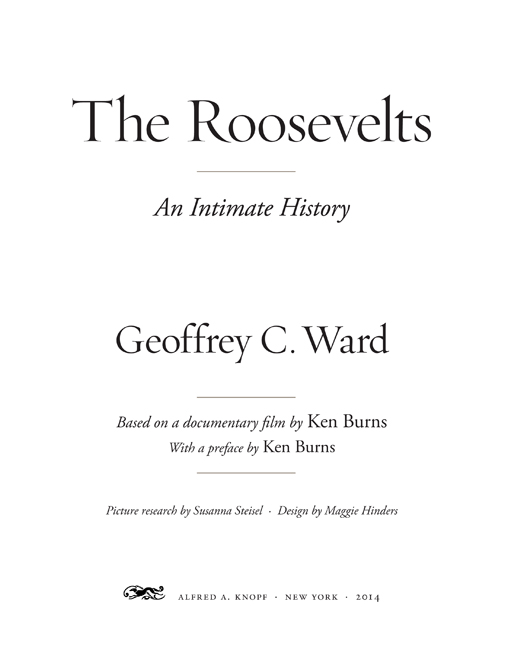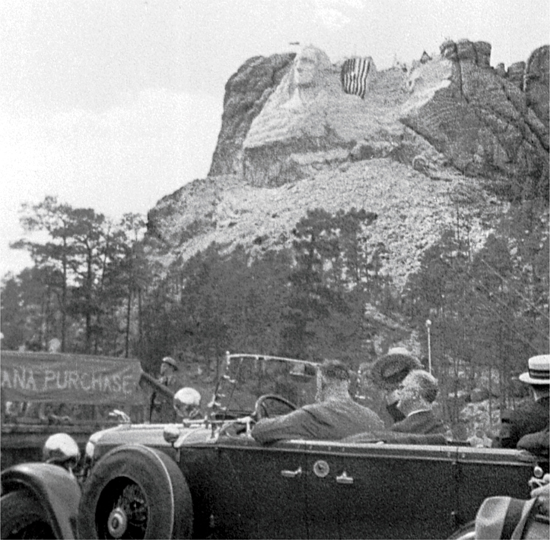Former president Theodore Roosevelt waves to the New York crowds gathered to greet him on his triumphant return from Africa and Europe, June 8, 1910. Franklin and Eleanor Roosevelt smile at the camera in front of the smokestack at the right. This and two other photographs made from the same vantage point the same day are the only known images that include all three of the most celebrated Roosevelts.
THIS IS A BORZOI BOOK
PUBLISHED BY ALFRED A. KNOPF
Copyright 2014 by Geoffrey C. Ward and Ken Burns
All rights reserved. Published in the United States by Alfred A. Knopf, a division of Random House LLC, New York, and in Canada by Random House of Canada Limited, Toronto, Penguin Random House companies.
www.aaknopf.com
Knopf, Borzoi Books, and the colophon are registered trademarks of Random House LLC.
ISBN: 978-0-307-70023-0 (hardcover) ISBN: 978-0-385-35306-9 (eBook)
Cover photographs (left): Theodore Roosevelt Collection, Houghton Library, Harvard University; (center and right) Franklin D. Roosevelt Presidential Library. Photo arrangement by Evan Barlow.
Cover design by Kelly Blair
v3.1
For the late Arthur M. Schlesinger, Jr.,
who helped us at the beginning,
and for William E. Leuchtenburg,
who has been helping us ever since
Contents
Preface
Emotional Archeology
One drowsy summer afternoon in 1908, in the fifth-floor offices of the law firm of Carter, Ledyard & Milburn, at 54 Wall Street in Manhattan, the junior clerks were idly talking about their dreams for the future. Most hoped just to become partners one day.
But one clerk had far bigger dreams. He didnt plan to practice law for long, he said. Instead, he intended to go into politics and eventually become president of the United States. The speaker was just twenty-five years old. He was then considered a charming lightweight, an enthusiastic dancer and golfer; he had been an undistinguished student and was now an indifferent lawyer. But no one laughed: his name, after all, was Franklin Roosevelt .
His fifth cousin, Theodore Roosevelt, was already president, the youngest and perhaps the most popular president in American history. And his rise to that office had once appeared just as unlikely as their fellow clerks chances now seemed.
Twenty-eight summers later, on August 30, 1936, that same once-distracted law clerk was in the Black Hills of South Dakota. He was now in fact, as he had brashly predicted he would be, the president of the United States. He was strugglingnow with a kind of focus and energy no one could have predicted and in spite of the after-effects of infantile paralysis that had left him unable even to stand unaidedto lift his country out of the greatest economic cataclysm in its history.
The president was there in South Dakota to offer some extemporaneous remarks from his open touring car at the unveiling of the massive head of Thomas Jefferson, the second presidential countenance to be carved out of Mount Rushmore. George Washingtons image had been dedicated six years earlier; the future faces of Abraham Lincoln and Franklin Roosevelts lifelong hero and distant cousin, Theodore Roosevelt, were unfinished, indistinct and unformed in the hard rock.
This is the second dedication, FDR declared, head tilted up, confident grin in place. And there will be others by other presidents. (In fact, only four portraits would ever be carved from the rock.) And I think that we can perhaps meditate a little on those Americans ten thousand years from now. I think we can wonder whether our descendantsbecause I think theyll still be herewhat they will think about us. And let us hope that at least they will give us the benefit of the doubt, that they will believe that we have honestly striven in our day and generation to preserve for our descendants a decent land to live in and a decent form of government to operate under.
The previous ten thousand years had seen the human race emerge from its primitive existence, had watched countless civilizations rise and fall, had witnessed mankinds astonishing inventiveness and its astounding brutality, and yet this man, humbled, even humiliated, by disease, unable to use his legs, his country ravaged by hard times, was certain that ten thousand years from then there still would be a human race, there still would be a United States of America, and there still would be people who would derive inspiration from the ideals the four men on the mountainand now heembodied. He had come a long way.
ABOVE AND FOLLOWING IMAGES FDR arriving at Mount Rushmore for the unveiling of the mammoth carving of Thomas Jefferson, here still hidden by a vast American flag; and making his dedicatory remarks from the backseat of his car

For nearly three decades, as we have worked together on other projects, Geoff Ward and I have talked about making a documentary film series having to do in some way with the Roosevelts. In the intervening years, there have been good films about each of them but none about them all. In his two accounts of FDRs early life, Before the Trumpet and A First-Class Temperament, Geoff argued both that Franklin and Eleanor Roosevelt would never have become the extraordinary individuals they became had it not been for the great example of Theodore RooseveltEleanors uncle and Franklins cousinand that the partisanship of their time and ours had obscured the fact that there was far more that united than divided them. That storya complex family drama that touches on historic events spanning a centuryis the one weve chosen to tell in this book and in the seven-part television series upon which it draws.
We decided to subtitle our work An Intimate History not because we wished to descend into the contrived dramas of psychobiography, but because we have always seen character and personal history as central to an understanding of the public person. Just as biography can often be an accurate barometer of an age, so too can an individuals inner motivations and experiences illuminate and reveal their actions on the larger stages of politics and society and war.
In this approach, we have consciously not subscribed to easy sentimentality or nostalgiathe enemy of any good historybut neither have we retreated to the supposed safety of merely excavating the dry dates, facts, and events of the past. We are interested in an emotional archeology that can painstakingly reassemble that past and its most compelling characters, reflecting both their inner as well as their outer lives. This kind of investigation embraces an ancient classical notion of heroismnot a modern one that demands only an impossible bland perfection. It implicitly acknowledges and explores not only a heros obvious strengths but his or her equally evident flaws as well. It is the negotiationsometimes the warbetween these qualities that in the end defines real heroism. That is certainly true of the two men and one woman whose lives this book explores.


